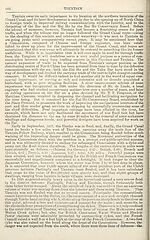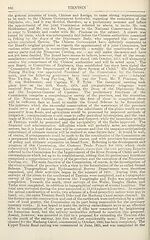1926
(643) Page 587
Download files
Complete book:
Individual page:
Thumbnail gallery: Grid view | List view

TIENTSIN
587
outer dyke, Haikuanssu dyke and Weitze Creek dyke; but from the north-west of
the Chinese City. Tientsin, being situated at the confluence of the Peiho, Yungtingho,
Hsiho and Yiinho or Grand Canal, was in an awkward position as the flood
water, unable to escape through Mach’ang on the Yiinho, and so along the south of
Tientsin to the sea, filled in the depression between the rivers above-named and
endeavoured later to force an outlet over the banks of the Yfinho into Tientsin from
the west. Meanwhile, the discharging capacity of the Haiho or lower Peiho was being
strained to its utmost by the immense volume of water from the Hsiho, Yungtingho
and Yunho debouching into it just above Tientsin. At times the volume of water
( discharged from the Haiho was 55,000 cubic feet per second and the speed of the
current over 5 feet per second. Tbe river naturally rose to abnormal heights and at
one time topped its banks in the German Concession but caused no damage. On
Saturday, August 2nd, the Red Bridge which stood at the north-west corner of
Tientsin, collapsed as a result of the water encroaching on the banks behind the
abutments. It was feared that this bridge lying on the river bed might cause a silting
up and a consequent raising of the river level at this point. So far, however, no such
effect has been noticeable. On Tuesday, August 5th, the Bridge of Boats collapsed and
was swept down by the current on to the Austrian Bridge, and, as the water was too
high to allow the released boats’ passage under this bridge, they had to be destroyed
with all possible speed to prevent destruction of the Austrian Bridge. On August
14th, a portion of the stone bunding outside the Imperial Hotel just above the
International Bridge collapsed and caused the authorities anxious moments until the
gap was filled in with rubble and bags filled with sand. A few days later a hole
appeared in the road at the southern extremity of the International Bridge into which
thousands of bags of sand and rubble had to be thrown before the cavity was finally
filled. This, too, caused no little apprehension, as it was feared that the current had
washed round the foundations of the abutments of this bridge. There were anxious
moments when the water in the Grand Canal reached the level of its banks, and
frantic efforts were made to raise the dykes. It was found, also, that seepage had
occurred in the banks of the Yiinho, near the Pei Yang Match Factory, which, were
it allowed to continue, would cause their undermining and consequent destruction.
They had to be strengthened and pumps were brought into action to force back the
water into the canal. During the flood the Peking-Tientsin Railway Service was not
interrupted, although the water was in some places several feet deep against the
railway track.
The question of conserving the waterways of the Chihli province, with a view
to preventing a recurrence of the disasters experienced in the past and safeguarding the
trade and shipping interests of Tientsin, has occupied attention for some years past,
and various conservancy engineers have individually issued reports on the subject; but
no co-ordinated scheme on broad lines and acceptable to all interests has so far been
adopted. A proposal was brought forward in the autumn of 1917 by the Commissioner
of Customs in connection with the appointment of a “joint-commission” composed of
representatives of the Chinese Government and of the Haiho Conservancy Board,
etc., to study the general question and submit recommendations for the considera¬
tion and acceptance of the Government. The following extract from the Board’s
Annual Report for 1917 outlines the nature of the action thus taken, which, it is
hoped, will prove effective:—“In view of the conflict of opinion between the
Board’s technical advisers and the National Conservancy Bureau on the general
.question of the prevention of floods in the Chihli province, the conservation of
the waterways of the hinterland, and more especially the measures which should
be adopted in regard to the Peiyiinho and the Yungtingho (better l<nown as the
Hunho), Mr. Maze urged the necessity of appointing, without further delay, a
joint Commission composed of three representatives of the Chine.-e Government
and three persons nominated by the Board—viz., Mr. T. Pincione, Mr. H. von
Heidenstain (Engineer in-Chief, Whangpoo Conservancy Board), and Mr. W. F.
Tyler (Coast Inspector) —- to study the important and far reaching questions
involved, which are of vital importance to the vast and growing trade of North
China, the shipping interests of Tientsin, and the welfare and prosperity of the
agricultural communities in the plains, and, ultimately, to submit recommendations
for the information and acceptance of the Chinese Government. The Board, at a
meeting on the 14th September, agreed to this proposal. The senior Consul,
therefore, was addressed accordingly and requested to make representations on the
subject to the Diplomatic Body with a view to obtaining the acquiescence of the
Chinese Government. Early in October the Board realised that it was essential in
587
outer dyke, Haikuanssu dyke and Weitze Creek dyke; but from the north-west of
the Chinese City. Tientsin, being situated at the confluence of the Peiho, Yungtingho,
Hsiho and Yiinho or Grand Canal, was in an awkward position as the flood
water, unable to escape through Mach’ang on the Yiinho, and so along the south of
Tientsin to the sea, filled in the depression between the rivers above-named and
endeavoured later to force an outlet over the banks of the Yfinho into Tientsin from
the west. Meanwhile, the discharging capacity of the Haiho or lower Peiho was being
strained to its utmost by the immense volume of water from the Hsiho, Yungtingho
and Yunho debouching into it just above Tientsin. At times the volume of water
( discharged from the Haiho was 55,000 cubic feet per second and the speed of the
current over 5 feet per second. Tbe river naturally rose to abnormal heights and at
one time topped its banks in the German Concession but caused no damage. On
Saturday, August 2nd, the Red Bridge which stood at the north-west corner of
Tientsin, collapsed as a result of the water encroaching on the banks behind the
abutments. It was feared that this bridge lying on the river bed might cause a silting
up and a consequent raising of the river level at this point. So far, however, no such
effect has been noticeable. On Tuesday, August 5th, the Bridge of Boats collapsed and
was swept down by the current on to the Austrian Bridge, and, as the water was too
high to allow the released boats’ passage under this bridge, they had to be destroyed
with all possible speed to prevent destruction of the Austrian Bridge. On August
14th, a portion of the stone bunding outside the Imperial Hotel just above the
International Bridge collapsed and caused the authorities anxious moments until the
gap was filled in with rubble and bags filled with sand. A few days later a hole
appeared in the road at the southern extremity of the International Bridge into which
thousands of bags of sand and rubble had to be thrown before the cavity was finally
filled. This, too, caused no little apprehension, as it was feared that the current had
washed round the foundations of the abutments of this bridge. There were anxious
moments when the water in the Grand Canal reached the level of its banks, and
frantic efforts were made to raise the dykes. It was found, also, that seepage had
occurred in the banks of the Yiinho, near the Pei Yang Match Factory, which, were
it allowed to continue, would cause their undermining and consequent destruction.
They had to be strengthened and pumps were brought into action to force back the
water into the canal. During the flood the Peking-Tientsin Railway Service was not
interrupted, although the water was in some places several feet deep against the
railway track.
The question of conserving the waterways of the Chihli province, with a view
to preventing a recurrence of the disasters experienced in the past and safeguarding the
trade and shipping interests of Tientsin, has occupied attention for some years past,
and various conservancy engineers have individually issued reports on the subject; but
no co-ordinated scheme on broad lines and acceptable to all interests has so far been
adopted. A proposal was brought forward in the autumn of 1917 by the Commissioner
of Customs in connection with the appointment of a “joint-commission” composed of
representatives of the Chinese Government and of the Haiho Conservancy Board,
etc., to study the general question and submit recommendations for the considera¬
tion and acceptance of the Government. The following extract from the Board’s
Annual Report for 1917 outlines the nature of the action thus taken, which, it is
hoped, will prove effective:—“In view of the conflict of opinion between the
Board’s technical advisers and the National Conservancy Bureau on the general
.question of the prevention of floods in the Chihli province, the conservation of
the waterways of the hinterland, and more especially the measures which should
be adopted in regard to the Peiyiinho and the Yungtingho (better l<nown as the
Hunho), Mr. Maze urged the necessity of appointing, without further delay, a
joint Commission composed of three representatives of the Chine.-e Government
and three persons nominated by the Board—viz., Mr. T. Pincione, Mr. H. von
Heidenstain (Engineer in-Chief, Whangpoo Conservancy Board), and Mr. W. F.
Tyler (Coast Inspector) —- to study the important and far reaching questions
involved, which are of vital importance to the vast and growing trade of North
China, the shipping interests of Tientsin, and the welfare and prosperity of the
agricultural communities in the plains, and, ultimately, to submit recommendations
for the information and acceptance of the Chinese Government. The Board, at a
meeting on the 14th September, agreed to this proposal. The senior Consul,
therefore, was addressed accordingly and requested to make representations on the
subject to the Diplomatic Body with a view to obtaining the acquiescence of the
Chinese Government. Early in October the Board realised that it was essential in
Set display mode to:
![]() Universal Viewer |
Universal Viewer | ![]() Mirador |
Large image | Transcription
Mirador |
Large image | Transcription
Images and transcriptions on this page, including medium image downloads, may be used under the Creative Commons Attribution 4.0 International Licence unless otherwise stated. ![]()
| Asian directories and chronicles > 1926 > (643) Page 587 |
|---|
| Permanent URL | https://digital.nls.uk/196496532 |
|---|
| Attribution and copyright: |
|
|---|---|
| Description | Volumes from the Asian 'Directory and Chronicle' series covering 1917-1941, but missing 1919 and 1923. Compiled annually from a multiplicity of local sources and research. They provide listings of each country's active corporations, foreign residents and government agencies of all nationalities for that year, together with their addresses. Content includes: various treaties; coverage of conflicts; currencies and taxes; consular fees; weights and measures; public holidays; festivals and traditions. A source of information for both Western states and communities of foreigners living in Asia. Published by Hongkong Daily Press. |
|---|---|
| Shelfmark | H3.86.1303 |
| Additional NLS resources: |

